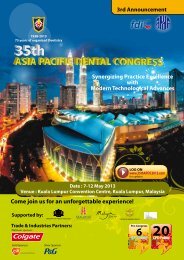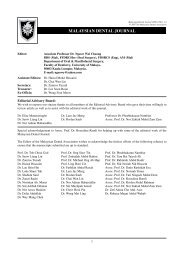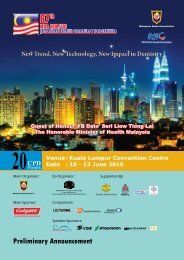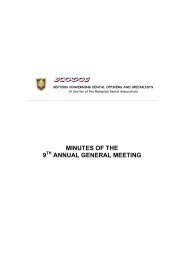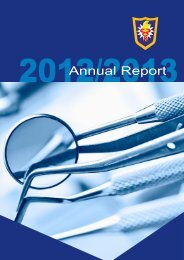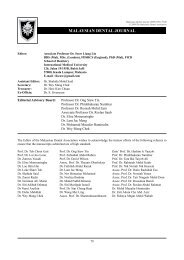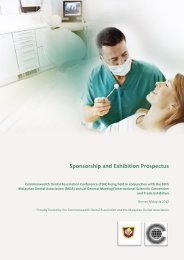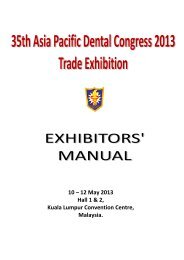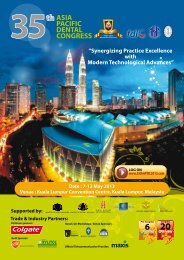PDF(6.5mb) - Malaysian Dental Association
PDF(6.5mb) - Malaysian Dental Association
PDF(6.5mb) - Malaysian Dental Association
- No tags were found...
You also want an ePaper? Increase the reach of your titles
YUMPU automatically turns print PDFs into web optimized ePapers that Google loves.
Prosthodontic Considerations In The Management Of Oligodontia In Growing Patientsbe a suitable option in Class III occlusal relationshipwith bulky canines. Significant tooth reduction maybe required to simulate the appearance of a lateralincisor. Therefore, definitive replacement with eithera tooth or implant supported restoration is morefavourable. Both options require adequate restorativespace, which necessitate orthodontic intervention.If implant is contemplated, consideration of bothocclusal and inter-radicular restorative space isimportant 19 . To modify the morphology of the anteriorteeth, composite build –ups were preferred to invasiveindirect restorations at this stage. This method offersa simple, conservative and reversible approach ofrehabilitation of forms and function in a growingpatient. Following orthodontic treatment, the spacefor tooth 22 can be maintained with either resinbonded bridge or removable orthodontic retainer 18 .The replacement options of the lowerincisors may include the use of removable partialdentures (RPD), conventional and adhesive bridgeas well as implant supported prostheses 6, 10 . In thiscase, removable partial overdenture replacing bothanterior and posterior teeth overlaying the submergedretained lower left E’s may be a reasonable andeconomic option. In growing patient, RPD allows theflexibility for adjustment in accordance to the needof the developing oro-facial structures 21 . For longterm provisional reasons, a metal cast denture isusually indicated. However, the patient has reportedpoor tolerance of removable appliance. Studies haveshown that the acceptance of removable prosthesisis highly dependent on the patient’s perception andattitude towards the treatment 21 . Moreover, themarked atrophy of the lower alveolar bone and thediscrepancies between both upper and lower archescomplicate the provision of RPD.Similar to the upper jaw, the rehabilitationof lower dentition can also include implants. Thepredictability of implant supported prosthesis asprosthetic rehabilitation of partially edentulous patienthas been well established by many studies. The generalsurvival rates of implants reported are mostly morethan 90% after 5-10 years 22 . Another long term studyby Lekholm et al 2006, a cumulative survival rate of 91%has been reported for both implants and prosthesisafter 20 years 23 . Early clinical reports showed that thefeasibility of using dental implants in growing adultsespecially in cases with multiple teeth agenesis 24 .Despite excellent result reported in the literature, theprimary concern for the use of implant in this group ofpatient was the possibility of infraocclusion due to theankylotic nature of osseointegrated implant that lacksbehind the continous eruption and growth of adjacentteeth or alveolar ridge 24 . Sharma & Vargerik (2006) 25outlined several practical guidelines with respectto implant placement in children. According to theauthors, implants can be placed in partially edentulouschildren keeping in mind the need for the prosthesisto be remade or future surgery to correct the jaw sizediscrepancy. In patient with missing single tooth withintact adjacent teeth such as in the upper jaw of thepresent case, the authors recommend abstaining fromimplant placement until cessation of growth.Nevertheless, data on dental long term successof implant remains scarce. Furthermore, severe atrophyof the alveolar ridge in the lower anterior edentuloussites resulted in the need for hard and soft tissuegrafting procedure prior to implant placement 24 . At thepresent stage, due to financial limitation, the patientkept away from this relatively expensive treatmentmodality.Another possible restorative option for thelower incisors is a fixed prosthesis spanning from 33to 43. Generally, the growth in the anterior region ofmandible is completed following fusion of mandibularsymphisis at around 1 year of age. After the age of 5,minimal changes in this region are expected. Therefore,placement of rigid prosthesis bridging the symphisismay not interfere with growth 26 . Resin bonded bridgehas become a viable long term treatment option.A meta analysis study by Creuger et al 27 reported apromising 4-year survival rate of 74%. However, therehas been a concern over the poor survival rate inpatients below the age of 20 especially in long spanprosthesis. The poor performance of RBBs was thoughtto be due to inadequate bonding area of young teeth 28 .Another disadvantage of using RBB in this patient isthat any future orthodontic tooth movement in theanterior region would be limited.On the other hand, a conventional bridgemay involve preparation of sound and healthy lowercanines. In addition, large pulpal chamber and shortclinical crown associated with the newly eruptedcanines add further risk to the teeth preparation 10 .In view of the limitations posed by the conventionalbridge, a less invasive resin bonded bridge seems to bea sensible fixed restorative choice.With regard to the retained tooth 75, extractionof deciduous molar before becoming submerged hasbeen advocated 29 . However in the present case, thedecision to maintain the submerged lower molar wasmade based on the need to preserve the alveolar ridgeuntil the provision of final restoration upon completionof his growth. Composite resin build-up of the affecteddeciduous molar was necessary to prevent overuptionof the antagozing teeth.CONCLUSIONThere is no doubt that optimal managementof patient with oligodontia requires multidisciplinarycollaboration .From the prosthodontist point of view,early determination of the type of definitive therapyforms the ‘road map’ for the joint managementduring growing phase. While treatment planning forfuture restorations is crucial, provi¬sion of an interim<strong>Malaysian</strong> <strong>Dental</strong> Journal Jan-Jun 2011 Vol 32 No 126



